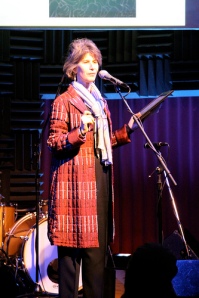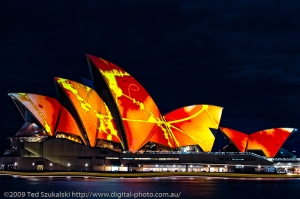Moving Walls and Digital Frescoes
April 3, 2010
 I have always had a fascination with walls.
I have always had a fascination with walls.
Here, I was about four. This was one of my dad’s theaters. I think it was backstage. But, I didn’t care: it was a wall that held a story, and that was what I loved – that was the family business – telling stories to strangers.
I have not fallen out of love with walls. In particular, I love walls in public spaces where people project images, blast music, make dances or create a commotion.
And, even though I work with digital technology, I still love a wall that stands outside of computers — but, I seriously love things made in computers that get projected out to ravish, and cling, and create a new way of looking at a wall. Either way, I love walls. I think this started with the theater.
Or, perhaps it started with my first mentor: Elise Bernhardt.
In the early 1980’s, Elise founded Dancing in The Streets. She had the chutzpah to put dances on the Brooklyn Bridge. Then, convinced Grand Central Station to let dancers take over the entire joint. Stephen Koplowitz had dancers in the windows, and Savion Glover tapped in the lower terminals. Merce Cunningham’s dancers dominated the huge central area of Grand Central and people were forced to walk around them to get to their trains. Chutzpah!
Here’s what I learned from Elise, and it’s good advice if you want to take over a building and put art in it, or have a really big dinner party:
– Pick the most exciting space you can find and decide, with total conviction, that it’s right.
– Envision the most exciting things possible in it.
– Admit that you can’t envision the most exciting things in it alone – find the most talented people to come up with more ideas.
– Ask people for money (or, fill in here, “Ask for pot luck”).
– Ask LOTS of people for money. And, then ask again. And, tell that the idea of dancers in windows, and people flying from walls, and digital images taking over buildings is GOOD for everyone. That people in public spaces looking at things together is what the history of culture is all about. That this work revitalizes community and puts attention on needed public space (which she proved from Redhook to Grand Central). And, then look them straight in they eye and say, “Plus, it’ll be gorgeous”.
– Then, make sure there is good food.
That’s pretty much it. Oh, and fall deeply in love with the knowledge that the walls of a public space can seem totally changed when people even remember having seen art in it.
A few years ago, I told Elise I missed big spaces with big things happening in them. She told me to call Zaccho Dance Theatre, and Joanna Haigood, and become their friend (That’s Elise in a nutshell really, just call for god’s sake, it’ll be gorgeous!) (www.zaccho.org) Zaccho is based in San Francisco and takes a blank space and flies off of it. Literally.
The picture above is of Zaccho doing a full digital projection on HUGE abandoned silos. The piece included Zaccho and the people that lived in a neighborhood where the closing of a plant had closed down the local economy. All the participants tried to imagine a time when there were fields – and not machines. Amazing way to look at history. Though, let’s put this into perspective – see those little dots on the silos? Those are dancers on harnesses who are flying/dancing within, up and down and around those silos. Well, this work meets my need for a Sistine chapel that moves. A small request…but why not.
And, why not??
Now that digital technology can do so much as a projected medium, why not have Sistine chapel environments up the ying yang? Obscura Digital here in San Francisco does this http://www.obscuradigital.com/ But, let’s be clear – OD is not an arts organization, not even a production company – they are a culture unto themselves who make really humongous projection based immersive events for huge companies. Oh, and sometimes a band. And, yes, huge domes for people to experience the sea. But, generally, they make products to mess with your head. They messed with the head of Carnegie Hall:
 The images wrapped the building. They moved. They were playing along with the music – talking and changing shapes. And, that was only a small example of what could be done with this level of digital imagery to a wall.
The images wrapped the building. They moved. They were playing along with the music – talking and changing shapes. And, that was only a small example of what could be done with this level of digital imagery to a wall.
There are artists, and technologists who are specifically focused on how to use digital technology as a form of paint (or movement/spacial changer/”head-messer-upper”) itself. And, these are the people who I am watching carefully – because art has often shifted into high gear – into a voice for a new era – when it is seen as a huge image, in a huge place (or in a small place with hug impact) but, always in a public place.
Last year there was a lovely homage to walls when 77 Million Paintings was projected live on the Sydney Opera House.
Brian Eno made these images and they run on an algorithm that makes it impossible for the same collection of images to ever been seen in your lifetime – each picture is seen once, and then regenerates (or gestates) for a very long time.
And, that is interesting – and wistful.
But, to me, the fact that he had those images shift and change, and exploded on those massive sails on a public meeting place, and that those images created a new memory precisely because they reframed (changed) that space (quite publicly) is quite touching – and wonderfully demanding.
Like I said, I’m just a sucker for blank spaces on walls.
And, I love to find them filled with something, someone, someplace we can remember: together.



